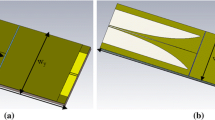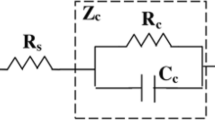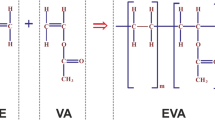Abstract
When an electrical current with a low frequency is applied to a cell, the current passes through the outside of the cell. Thus, impedance measurements at low frequencies cannot be used to determine the pathological change of the cellular organelle taking place inside the cell. However, increasing the frequency of the electrical current makes the capacitive impedance of the cell decrease, allowing the electrical current to flow through the cell. This study presents the design and fabrication of a microfluidic device integrated with a coplanar waveguide open-ended micro-electro-mechanical-systems (MEMS) probe for the impedance measurement of the single HeLa cell in frequencies between 1 MHz and 1 GHz. The device includes a poly-dimethlysiloxane (PDMS) cover with a microchannel and microstructures to capture the single HeLa cell and a conductor-backed CPW fabricated using a silicon chip and two printed circuit boards (PCB). The effects of the substrate on the characteristic impedance of the conductor-backed coplanar waveguide (CBCPW) structure were investigated under three conditions by utilizing a time-domain reflectometer (TDR). Finally, impedance measurements using the proposed device and a vector network analyzer (VNA) are demonstrated for de-ionized (DI) water, alcohol, PBS, and a single HeLa cell.












Similar content being viewed by others
References
Ayliffe HE, Frazier AB, Rabbitt RD (1999) Electric impedance spectroscopy using microchannels with integrated metal electrodes. J Microelectromech S 8:50–57
Bedair SS, Wolff I (1992) Fast, accurate and simple approximate analytic formulas for calculating the parameters of supported coplanar waveguides for MMIC’s. IEEE T Microw Theory 40(1):41–48
Beilenhoff K, Heinrich W, Hartnagel HL (1992) Finite-difference analysis of open and short circuits in coplanar MMIC’s including finite metallization thickness and mode conversion. IEEE MTT-S Int Microw Symp Dig 1:103–106
Beilenhoff K, Klingbeil H, Heinrich W, Hartnagel HL (1993) Open and short circuits in coplanar MMIC’s. IEEE T Microw Theory 41(9):1534–1537
Bérubé D, Ghannouchi F, Savard P (1996) A comparative study of four open-ended coaxial probe models for permittivity measurements of lossy dielectric/biological materials at microwave frequencies. IEEE Trans Microw Theory Tech 44(10):1928–1934
Chmiola J, Yushin G, Dash RK, Hoffman EN, Fischer JE, Barsoum MW, Gogotsi Y (2005) Double-layer capacitance of carbide derived carbons in sulfuric acid. Electrodhem Solid St 8:A357–A360
Fouad HV (1980) Finite boundary corrections to coplanar stripline analysis. Electron Lett 16(15):604–606
Gawad S, Cheung K, Seger U, Bertsch A, Renaud P (2004) Dielectric spectroscopy in a micromachined flow cytometer: theoretical and practical considerations. Lab Chip 4:241–251
Ghione G, Naldi C (1983) Parameters of coplanar waveguides with lower ground plane. Electron Lett 19(18):734–735
Gomez R, Bashir R, Sarikaya A, Ladisch MR, Sturgis J, Robinson JP, Geng t, Bhunia AK, Apple HL, Wereley S (2001) Microfluidic bioship for impedance spectroscopy of biological species. Biomed Microdev 3:201–209
Heiskanen Arto R, Spegel Christer F, Natalie K, Tautgirdas R, Jenny E (2008) Monitoring of saccharomyces cerevisiae cell proliferation on thiol-modified planar gold microelectrodes using impedance spectroscopy. Langmuir 24:9066–9073
Hilberg W (1969) From approximations to exact relations for characteristic impedances. IEEE T Microw Theory 17(5):259–265
Hobbie RK (1997) Intermediate physics for medicine and biology, 3rd edn. American Institute of Physics, New York
Huang Y, Wang XB, Holzel R, Beckert FF, Gascoynet PRC (1995) Electrorotational studies of the cytoplasmic dielectric properties of Friend murine erythroleukaemia cells. Phys Med Biol 40(11):1789–1806
Jang LS, Wang WH (2007) Microfluidic device for cell capture and impedance measurement. Biomed Microdevices 9(5):737–743
Kitazawa T, Hayashi Y (1987) Variational method for coplanar waveguide with anisotropic substrates. IEE Proc H Microw Antennas Propag 134(1):7–10
Lohndorf M, Schlecht U, Gronewold TMA, Malave A, Tewes M (2005) Microfabricated high-performance microwave impedance biosensors for detection of aptamer-protein interactions. Appl Phys Lett 87: 243902
Markx GH, Davey CL (1999) The dielectric properties of biological cells at radiofrequencies: applications in biotechnology. Enzyme Microb Technol 25:161–171
Messina TC, Dunkleberger LN, Mensing GA, Kalmbach AS, Weiss R, Beebe DJ, Sohn LL (2003) A Novel high-frequency sensor for biological discrimination. In: The 7th International Conference on Micro Total Analysis Systems
Olapinski M, Manus S, Fertig N, Simmel FC (2007) Probing whole cell currents in high-frequency electrical fields: identification of thermal effects. Biosens Bioelectron 23:872–878
Pething R, Kell DB (1987) The passive electrical properties of biological systems: their significance in physiology, biophysics and biotechnology. Phys Med Biol 32:933–970
Ramo S, Whinnery JR, and Duzer TV (1994) Fields and waves in communication electronics. secs. 2.5, 3.16, 3.17, 3.18, and 5.11. Wiley, New York
Rauch W, Gornik E, Solkner G, Valenzuela AA, Fox F, Bechner H (1993) Microwae properties of YBa2Cu3O7 − x Thin films studied with coplanar transmission line resonators. J Appl Phys 73:1866–1872
Schuy S, Janshoff A (2006) Microstructuring of phospholipid bilayers on gold surfaces by micromolding in capillaries. J Colloid Interface Sci 295(1):93–99
Simon RN (2001) Coplanar waveguide circuits, components, and systems. Wiley, New York
Simons RN, Ponchak GE (1988) Modeling of some coplanar waveguide discontinuities. IEEE T Microw Theory 36(12):1796–1803
Sun T, Green NG, Morgan H (2007) Analytical and numerical modeling methods for impedance analysis of single cells on-chip. Nano 3(1):55–63
Templer RH, Ces O (2008) New frontiers in single-cell analysis. J R Soc Interface 5:S111–S112
Veyres C, Hanna VF (1980) Extension of the application of conformal mapping techniques to coplanar lines with finite dimensions. Int J Electron 48(1):47–56
Wei YZ, Sridhar S (1989) Technique for measuring complex dielectric constants of to 20 GHz. Rev sci Instrum 60(9):3041–3046
Wen CP (1969) Coplanar waveguide: a surface strip transmission line suitable for nonreciprocal gyromagnetic device applications. IEEE T Microw Theory 17(12):1087–1090
Acknowledgments
This study was supported by the National Science Council, Taiwan, R.O·C., (NSC 96-2221-E-006-289), and made use of shared facilities provided under the Program of Top 100 Universities Advancement funded by the Ministry of Education in Taiwan. The authors would also like to thank the Center for Micro/Nano Science and Technology at National Cheng Kung University and the National Nano Device Laboratories for access granted to major equipment throughout the duration of this study and for their general technical support.
Author information
Authors and Affiliations
Corresponding author
Rights and permissions
About this article
Cite this article
Jang, LS., Li, HH., Jao, JY. et al. Design and fabrication of microfluidic devices integrated with an open‐ended MEMS probe for single‐cell impedance measurement. Microfluid Nanofluid 8, 509–519 (2010). https://doi.org/10.1007/s10404-009-0480-z
Received:
Accepted:
Published:
Issue Date:
DOI: https://doi.org/10.1007/s10404-009-0480-z




